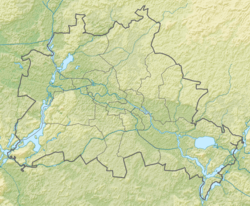You can help expand this article with text translated from the corresponding article in German. (April 2020)Click [show] for important translation instructions.
|
| Old Synagogue | |
|---|---|
German: Alte Synagoge | |
 Engraving of the former synagogue, undated | |
| Religion | |
| Affiliation | Judaism (former) |
| Rite | Nusach Ashkenaz |
| Ecclesiastical or organisational status | Synagogue (1714–1942) |
| Status | Destroyed(during WWII) |
| Location | |
| Location | Heidereutergasse 4, Marienviertel, Berlin |
| Country | Germany |
Location of the former synagogue in Berlin | |
| Coordinates | 52°31′16″N13°24′17″E / 52.5211°N 13.4048°E |
| Architecture | |
| Architects |
|
| Type | Synagogue architecture |
| Established | 1642 (as a congregation) |
| Groundbreaking | 1712 |
| Completed | 1714; 1855 |
| Destroyed | November 1942 |
The Old Synagogue (German : Alte Synagoge) was a Jewish congregation and synagogue, that was located at Heidereutergasse 4, in Marienviertel, in the present-day Mitte district of Berlin, Germany.
Designed and built by Michael Kemmeter, the synagogue was built as a rectangular hall building. Consecrated in 1714 and remodelled in 1855, [1] the synagogue was known as the Great Synagogue until the opening of the New Synagogue, built in the 1860s to accommodate Berlin's expanding Jewish population. [2] Nevertheless, services continued to be held in the Old Synagogue into the 20th century; it was restored in 1928. [3]
The synagogue survived Kristallnacht but was destroyed during World War II. The last service took place in the Old Synagogue on November 20, 1942. [1] The site is marked with a plaque and part of the building's contours are marked with cobblestones. [4]
